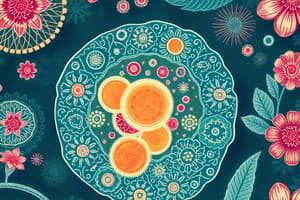Podcast
Questions and Answers
What is the primary function of the Golgi apparatus?
What is the primary function of the Golgi apparatus?
- Breaks down waste materials
- Modifies proteins before use or export from the cell (correct)
- Produces energy for the cell
- Contains the cell's genetic information
What occurs to a cell placed in a hypertonic solution?
What occurs to a cell placed in a hypertonic solution?
- The cell shrinks as water flows out (correct)
- The cell maintains its shape
- The cell bursts from excess pressure
- The cell swells due to excess water intake
Which structure is responsible for the production of proteins?
Which structure is responsible for the production of proteins?
- Nucleus
- Ribosome (correct)
- Cell membrane
- Mitochondria
Which of the following organelles contains its own DNA?
Which of the following organelles contains its own DNA?
What is the function of lysosomes in a cell?
What is the function of lysosomes in a cell?
What is the primary characteristic of passive transport?
What is the primary characteristic of passive transport?
Which of the following processes is considered active transport?
Which of the following processes is considered active transport?
Which of the following processes does NOT require energy?
Which of the following processes does NOT require energy?
In which transport process do substances move from an area of low concentration to an area of high concentration?
In which transport process do substances move from an area of low concentration to an area of high concentration?
Which transport process involves moving materials out of the cell?
Which transport process involves moving materials out of the cell?
What is the role of protein pumps in cell transport?
What is the role of protein pumps in cell transport?
How do passive and active transport methods differ fundamentally?
How do passive and active transport methods differ fundamentally?
What type of solution causes water to move into a cell, making it swell?
What type of solution causes water to move into a cell, making it swell?
Flashcards are hidden until you start studying
Study Notes
Cell Types
- Prokaryotic cells lack a nucleus and other membrane-bound organelles.
- Eukaryotic cells have a nucleus and other membrane-bound organelles.
Organelles
- Mitochondria: Powerhouse of the cell; breaks down glucose for energy production.
- Nucleus: Contains DNA, controls cellular functions.
- Golgi Apparatus: Modifies proteins and prepares them for export.
- Ribosomes: Produce proteins using instructions from DNA.
- Cytoplasm: Fluid inside the cell.
- Cell Wall: Provides support and structure; found in plant cells, made of cellulose.
- Cell Membrane: Selectively permeable barrier surrounding the cell.
- Lysosomes: Contain enzymes for breaking down waste and invading bacteria.
- Chloroplasts: Found only in plant cells, use sunlight to produce energy.
Diffusion and Osmosis
- Diffusion: Movement of particles from high to low concentration.
- Osmosis: Movement of water across a selectively permeable membrane from high to low water concentration (diffusion of water).
- Hypertonic Solution: Water moves out of the cell causing it to shrink due to higher solute concentration outside the cell.
Cell Transport
- Passive Transport: Movement of substances across a membrane without energy input.
- Diffusion: Movement from high to low concentration.
- Facilitated Diffusion: Diffusion assisted by proteins.
- Osmosis: Diffusion of water across a selectively permeable membrane.
- Active Transport: Movement of substances across a membrane against the concentration gradient - requires energy input.
- Protein Pumps: Proteins that move substances using energy.
- Exocytosis: Moving material out of the cell through membrane fusion.
- Endocytosis: Taking material into the cell.
Transport Processes
- Isotonic Solution: Equal solute concentration inside and outside the cell; no net water movement.
- Hypotonic Solution: Lower solute concentration outside the cell; water moves into the cell.
Summary Diagram
- A Venn Diagram illustrates the characteristics shared and unique to passive and active transport.
- Overlap (Both): Concentration gradient, movement across the cell membrane.
- Passive Transport: No energy requirement
- Active Transport: Requires energy (ATP).
Studying That Suits You
Use AI to generate personalized quizzes and flashcards to suit your learning preferences.




